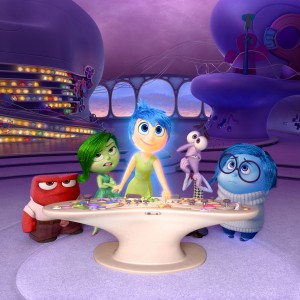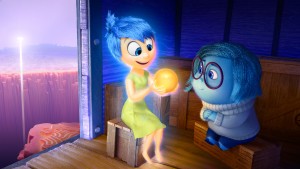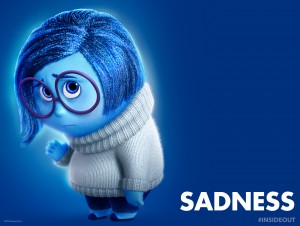Joy. Fear. Anger. Sadness. Disgust.
#AllTheFeels shone onscreen at the June 4 sneak preview of Inside Out in downtown Seattle. And as the credits rolled — as the audience sleeve-swiped tears of joy and laughter and sadness — director Pete Docter and producer Jonas Rivera proceeded down the aisle like royalty, making their way to the front for a rock-star reception.
 Generous with their time, Docter and Rivera turned their movie inside out, regaling us with surprising behind-the-scenes anecdotes about how the movie developed over five years, how it was written and rewritten, how they decided on their cast members, and how the cast responded to invitations to play particularly emotional characters.
Generous with their time, Docter and Rivera turned their movie inside out, regaling us with surprising behind-the-scenes anecdotes about how the movie developed over five years, how it was written and rewritten, how they decided on their cast members, and how the cast responded to invitations to play particularly emotional characters.
Mindy Kaling, for example — who agreed to play the scowling green nay-sayer called Disgust — shed tears when she read the plot description. “The fact that you guys are trying to make a movie that tells little girls that it’s hard to grow up and it’s okay to be sad about it,” she said, “is really profound.”
“I told Pete, ‘Write that down. That’s really good,‘” said Rivera. And that, he said, is when he realized how meaningful this could be to daughters.
Docter confirmed something I’d suspected as I watched the film: that the color of Joy’s hair was, for the animators, a meaningful, deliberate choice. Originally, he said, Joy had orange hair, not blue. “But something about her being the main character, and where we take her — we go all the way to Sadness, and then Joy cries — felt pretty profound to us. We wanted to visually explore that, so that she has the most dynamic range color-wise. We like that she has a little bit of sadness in her already. It seems like a nice symbolic link.”
Some characters’ colors seemed like obvious choices: Sadness (blue), Disgust (green), Joy (sunshine yellow). One wasn’t so easy. “We hope,” Rivera said, “that forevermore purple is the color of fear.”
But the most shocking and memorable revelation for me — not just as a fan but as a writer — was that Docter started rewriting the story from scratch late in the process. Docter says:
The initial pairing with Joy was Fear. That was chosen because — I don’t know about you guys, but fear was an essential part of my junior high experience. It drove a lot of my decisions. We thought ‘There’s good entertainment there.’
It was about three years in. Imagine this! We’ve done all this research, with three years of work, and I’m sitting in Editorial going, ‘This movie doesn’t work. I don’t know what this movie is supposed to add up to. Joy is supposed to pull herself together, go back to Headquarters, and do… what? I don’t know.’
So I’m walking around that weekend — it was Father’s Day — and I’m thinking ‘I should just quit. I’m a failure. The other two movies are a fluke. What would I miss? I’d miss my house. I’d miss the studio. The thing I’d miss the most would be my friends. And then it sorta hit me… the people I feel the closest to are not only the people I’ve had good times with, but people I’ve been pissed off at and sad with. We’ve suffered the loss of close friends. I’ve been scared for them.‘ And I realized, ‘That’s the subject matter I’m dealing with here. Emotions are the keys to the most important things in our lives.’
And I rush back, I’m all sweaty, I call Jonas on the phone, and Ronny Del Carmen who’s a co-director, and we meet for drinks that evening. And I pitch this half-fevered idea of re-doing the whole story without Fear, and instead pairing Joy with Sadness. And I’m kind of expecting Jonas as producer to go ‘Uhhhh….” But instead he lights up and everybody walks out of there on fire, ready to go. And when we pitched it to John [Lasseter] —which was a little scary because he’s expecting a screening and instead he’s got me waving my arms saying ‘It’s going to be great!’ — even in that situation, John and Edward were very supportive and realized that this was going to be a better film.
So we quickly retooled and redid the entire film. And that’s not the only time we did that. We made the film seven or eight times.
The audience might have stayed all night if their special guests had kept talking.
 I know I would have. And so I leapt at the opportunity to meet with Docter and Rivera the next morning at a roundtable interview with two other film bloggers: Jeff Totey of Beliefnet and Tracy of Skewed’n’Reviewed. Here are some highlights of that conversation:
I know I would have. And so I leapt at the opportunity to meet with Docter and Rivera the next morning at a roundtable interview with two other film bloggers: Jeff Totey of Beliefnet and Tracy of Skewed’n’Reviewed. Here are some highlights of that conversation:
O: I was up all night thinking about it.
Docter: So were we. For five years.
Rivera: You get so close to it that you don’t even know how to judge it. Three or four years in you’re like… ‘What are we doing?’ Does this make any sense? Then you start seeing it come together, and it starts to feel right, and you come out into the world and put it on the road and people respond… it’s just really rewarding.
Tracy: How was the concept of the film born?
Docter: It was born with the thought of emotions as characters. I knew that there had been movies that take place inside the human body. I was just doing a mind exercise: What would be fun to play with? And emotions seemed like right what animation does best: strong, opinionated, caricatured personalities. About that time my daughter was 11, and she was going through a big kind of change, as kids do from playing underground with dolls to being a little more quiet. and that change made me wonder what was going on inside her head. Maybe we could explore that a little bit.
Rivera: It was an easy thing for me to hook into as a parent. When he pitched it to me I thought this is a great opportunity for a movie: It’s familiar but foreign at the same time. No one’s seen these things, but have probably thought about anger and having dreams. It felt like a great opportunity visually and narratively.
O: I just watched Song of the Sea. I was thinking that this happens once in a while for entertainment. In Song of the Sea, we had emotions trapped in jars, and it was about releasing them. Is there something in the air right now? Why right now would it be a good time to talk with kids and parents about emotions? Is there something driving the subject right now that makes it especially urgent for you?
 Rivera: It’s an interesting question. Pete has talked about the point of origin, watching his 11-year-old grow up and change. My kids are younger. Just this morning my wife calls because she’s on the road and she can’t find the phone because our 9-year-old had it and lost it. Is there something in these kids being born into the iPhone generation, and it’s all about connectivity, through some backfire it’s almost seems [we’re] more distant. I notice a craving, because of all that, more connection to our kids. It’s a concern I have, that maybe we’re overcompensating in some way to try to reconnect.
Rivera: It’s an interesting question. Pete has talked about the point of origin, watching his 11-year-old grow up and change. My kids are younger. Just this morning my wife calls because she’s on the road and she can’t find the phone because our 9-year-old had it and lost it. Is there something in these kids being born into the iPhone generation, and it’s all about connectivity, through some backfire it’s almost seems [we’re] more distant. I notice a craving, because of all that, more connection to our kids. It’s a concern I have, that maybe we’re overcompensating in some way to try to reconnect.
O: It’s like the devices keep us from being in touch with ourselves.
Docter: Which is weird, because the iPhones are all about connectivity! People are obsessed with it. Even Mindy Kaling was saying that she can’t imagine going somewhere alone because she wouldn’t feel like it had really happened unless she was able to share it with people. And yet there’s this weird distance that happens when I’m looking at this [He holds up his phone.] and now I’m disconnected from you guys.
Totey: [To Docter.] I understand that you’re a Christian. [To Rivera.] I don’t know what your faith background is.
Rivera: [amused] I’m a fairweather Catholic at best.
Totey: I’m curious. Does that have any conflict at all with what you do? I have no problem with any stuff at Pixar, but…
Docter: I always feel that the most effective stuff is when it’s not too preachy. A lot of Christian folks have asked ‘When are you going to make a real Christian film?’ And I feel like… that’s not really the way to go about it. I feel like… who I am comes out in the work. And what you believe comes out in your actions.
Totey: I appreciate what you’re saying. I was just wondering if you’ve ever come up against the studio or somebody who wanted to go one way and you thought, ‘I don’t feel good about that.’
Docter: There are a lot of belief systems at work. But I feel like ‘The Gospel of Pixar’ is really about community. And all of the films are about someone who feels outside in some way and reconnecting with a group, and re-finding their family. And in a way, that’s our story. I was a nerd. I didn’t fit in with anybody in high school. I went for a long time without close friends. But then you get to a place called Pixar and everybody else can quote Chuck Jones cartoons and knows Peanuts comic strips. So the films reflect our own craving for closeness and community. So there’s never been any problems with what you’re talking about.
O: I’ve noticed some parallels in recent years with the way U2 gets treated in the press and the way Pixar gets treated. It’s almost like you’ve become so successful that people are rooting for you to fail. They want to see legends go down. Have you felt pressure on the storytelling team, as there’s more attention and higher expectations of your team? And at the same time, considering the change in chemistry there — with Brad Bird going off and doing his own thing, and Andrew Stanton going off and doing his own thing — I wonder how that’s changing the process. Have you changed anything in your procedures? Have you learned lessons that has changed your approach to storytelling?
Docter: That’s… a deep well.
 Rivera: We have noticed…. This isn’t to be defensive at all, but it has felt like some of the reviewers, for instance on Brave, will compare our films to our other films. They’ll say, ‘It’s really great. But it’s not as great as their others.’ And I think, ‘That’s funny. I never see that in a Warner Brothers review.‘ ‘That’s a great Warner Brothers movie… not the best Warner Brothers movie.’ We look at that and think, ‘Well, that’s a good thing. We have a brand, and there’s an expectation. We’ll take that.’
Rivera: We have noticed…. This isn’t to be defensive at all, but it has felt like some of the reviewers, for instance on Brave, will compare our films to our other films. They’ll say, ‘It’s really great. But it’s not as great as their others.’ And I think, ‘That’s funny. I never see that in a Warner Brothers review.‘ ‘That’s a great Warner Brothers movie… not the best Warner Brothers movie.’ We look at that and think, ‘Well, that’s a good thing. We have a brand, and there’s an expectation. We’ll take that.’
We don’t expect that everybody’s going to like them all the same. But we don’t put one out and say, ‘Boy, I hope it’s better than Up.’ We don’t even think ‘Boy, I hope it makes more money.’ We hope it makes enough money that they’ll let us make another one. That’s our real metric. I think it comes with the territory.
I’m guessing the boys in U2 would probably say something similar.
Other than stop… we can’t do anything else other than keep making stuff.
Docter: We had such an unbelievable run from Toy Story through … wherever you want to draw the line… of critical, audience, and monetary success. We just had, kind of, everything. And it wasn’t easy. It makes you appreciate how special and unique that time is when it does work.
Rivera: And as far as it changing, it’s always been changing. Bird…
Docter: Brad came in and that changed a lot of stuff… when he came in for The Incredibles.
Rivera: It was a nice shot in the arm. It felt like it was a different cadence. We still talk to those guys all the time. Brad came in and was important in the early days of this movie.
Docter: If you were going to write a book about it, I think there’s probably three or so phases of featured film from the feeling of the early days from Toy Story and A Bug’s Life, when it felt like it just people in a garage doing it for fun, and then it fell into more of a rhythm, and then things have gotten bigger. My point with all that is that it’s changed several times over the course of the 25 years things have been going on.
Rivera: It hasn’t changed in terms of how we develop things. There’s still a great volley. We start off with the nugget of an idea. When we brought in Lasseter on this, it was just a very small idea — it was a big idea, but it wasn’t developed more than a page. And he sat forward, like what we’d hope the audience would do — and that was enough for us to keep going. We’d put up rough reels and get Bird’s and Andrew’s notes. And that’s how it was on A Bug’s Life. Although this company has scaled up and it’s enormous now — there’s 1,200 people and there was 110 on Toy Story — I’m really proud of the fact (I think this comes from Ed Catmull and John and all of us that have grown up there) that it’s retained that DNA of ‘This is a director-driven studio.’ We know more about the world, but we’re just going to focus on what we do and do our best to keep going.
I think Inside Out is one of the more profound movies I’ve seen. Given that after raising three sons, I’m now raising daughter, it really hit home with me.
Yeah, you can tell that the storytellers are parents writing for parents. And yet, even though I’m not a parent, I got pretty choked up both times I saw it. And it isn’t cheap sentimentality that moves people — it’s truth. We’re grieving for all that our children will lose as they grow up, but we’re also grieving for those territories and characters who once lived in our imaginations.